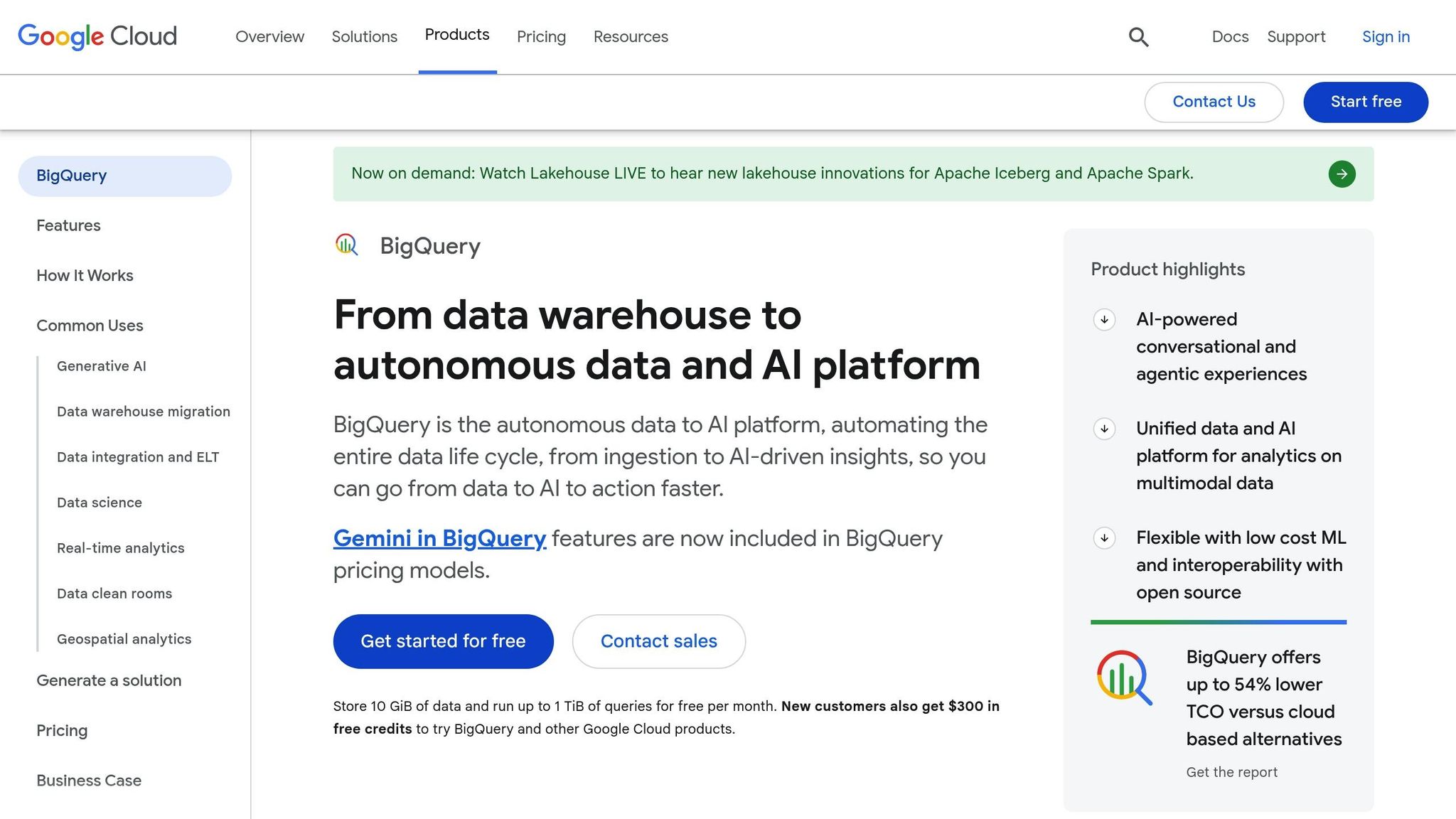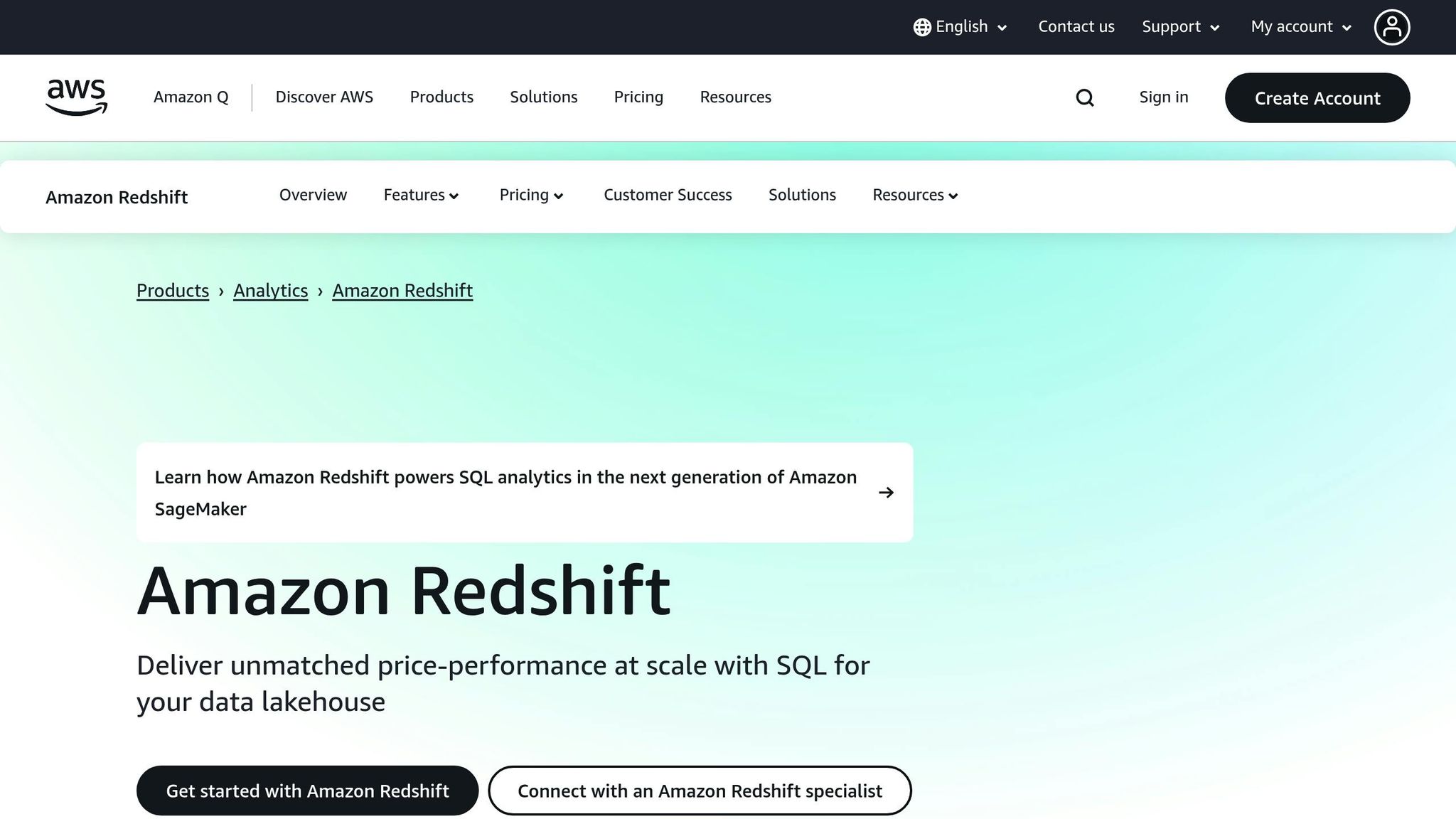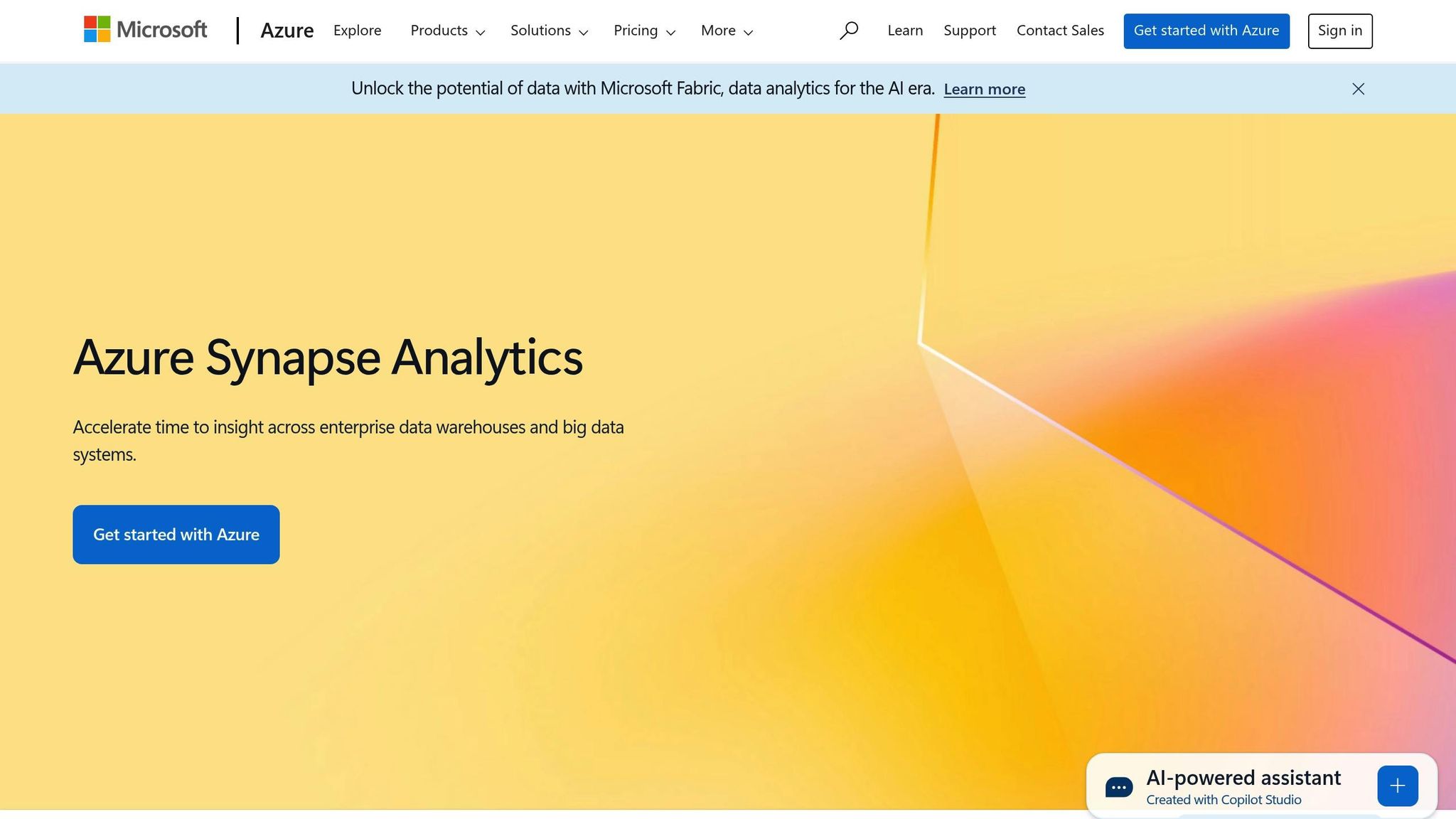In 2025, businesses face rising data challenges, and choosing the right data warehousing tool is critical. This article compares Snowflake, Google BigQuery, Amazon Redshift, and Microsoft Azure Synapse Analytics based on scalability, performance, integration, and pricing. Here's what you need to know:
- Snowflake: Flexible resource scaling, strong multi-cloud support, and advanced performance features. Great for dynamic workloads but can be costly for continuous usage.
- Google BigQuery: Serverless design with automatic scaling and real-time analytics. Best suited for Google Cloud users; less ideal for multi-cloud strategies.
- Amazon Redshift: Deep AWS integration, strong performance for structured data, and cost-effective for predictable workloads. Requires manual scaling and AWS expertise.
- Azure Synapse Analytics: Combines data warehousing and analytics with flexible scaling. Ideal for Microsoft environments but has a steeper learning curve.
Quick Comparison
| Tool Name | Scalability | Performance Features | Integration Strengths | Pricing Model |
|---|---|---|---|---|
| Snowflake | Auto-scaling; instant elasticity | Query acceleration, caching, clustering | Multi-cloud, dbt, AI integrations | Pay-per-use; compute/storage separate |
| Google BigQuery | Serverless; automatic scaling | BI Engine, materialized views | Google Cloud tools, AI models | Pay-per-query or capacity-based |
| Amazon Redshift | Manual scaling; serverless option | MPP, query caching, WLM | AWS ecosystem, real-time streaming | Pay-per-use; reserved instances |
| Azure Synapse | Dedicated/serverless pools | Materialized views, column indexing | Microsoft tools, Power BI | Pay-as-you-go or reserved capacity |
Each platform has strengths tailored to specific business needs. Snowflake excels in flexibility, BigQuery in simplicity, Redshift in AWS alignment, and Synapse in Microsoft integration. Choose based on your workload, cloud ecosystem, and budget.
Cloud Data Warehouse Benchmark Redshift vs Snowflake vs BigQuery | Fivetran
1. Snowflake
Snowflake is a cloud-based data warehouse built to handle large-scale data needs with ease. Its architecture separates computing power from storage, enabling businesses to adjust resources independently based on their specific requirements. This design has made it a popular choice among U.S. companies tackling complex data challenges.
Scalability
Snowflake's multi-cluster shared data architecture stands out from traditional data warehouses. By using virtual warehouses for query execution, it avoids resource conflicts and eliminates the bottlenecks often seen in older systems. This means multiple teams can run queries simultaneously without slowing each other down.
The platform's instant elasticity allows businesses to scale up or down as needed. Whether during peak demand or quieter times, companies only pay for the resources they use. This flexibility is a game-changer for organizations with fluctuating data processing needs.
Take AMN Healthcare, for example. They achieve a 99.9% pipeline success rate and have cut data warehouse runtime by 75% using Snowflake's virtual warehouses. Every day, they write over 100 GB of data and replicate 1,176 tables to Snowflake while consistently meeting their service level agreements.
Similarly, Pizza Hut relies on Snowflake's elasticity during high-impact events like the Super Bowl. With near-real-time analytics, they can handle massive traffic spikes without any drop in performance.
Snowflake also introduces Dynamic Tables, which can improve performance by up to 10x for certain workloads compared to traditional full refresh operations. These tables simplify pipeline management by automating refresh schedules based on data freshness, making it easy to transition from batch to streaming pipelines with just a single parameter adjustment.
With scalability at its core, Snowflake also focuses on delivering outstanding performance through advanced optimizations.
Performance Optimization
Snowflake continuously enhances performance without requiring user intervention. Since August 2022, the platform has reduced average query durations for stable workloads by 40%, while the Snowflake Performance Index has improved by 20% in just a year.
The platform includes features like query acceleration service (QAS), advanced caching, clustering, materialized views, and search optimization services. Together, these tools help reduce query times and ensure efficient resource usage across various workloads.
For instance, Yamaha Corporation uses Snowflake's multi-cluster architecture to eliminate resource bottlenecks, speeding up visualization rendering in Tableau. They also leverage Snowflake-powered machine learning models to expand their data analytics capabilities.
Snowflake's columnar data storage is optimized for queries that retrieve specific columns from wide tables. Combined with intelligent orchestration, auto-scaling, and query tuning, businesses can see performance boosts of up to 50% and cost savings between 30–50%.
Integration Capabilities
Snowflake's integration ecosystem is vast, supporting over 14,000 marketing vendors and serving more than 9,800 customers who rely on its AI Data Cloud for their marketing stacks. The platform works seamlessly with analytics tools, business intelligence software, customer data platforms, and marketing engagement systems.
For example, Sainsbury's uses Snowflake Streams and Tasks to process transaction and click-stream data in real-time, creating a unified data source across all its brands. This has expanded data access and sparked innovation throughout the company.
The Snowflake Native App Framework ensures secure and privacy-compliant integrations. IPG's Interact platform, for example, uses this framework to deliver cross-channel identity recognition and advanced marketing insights. Similarly, KINESSO employs Snowflake to power its Media Mix Models, analyzing millions in ad spend to guide smarter investments.
Snowflake also supports dbt directly, enabling data teams to manage dbt projects within the platform. Additionally, the introduction of Snowflake Openflow, built on Apache NiFi, aims to eliminate data silos and streamline data ingestion.
These integrations highlight Snowflake’s ability to adapt to diverse and demanding workloads.
Pricing
Snowflake's pricing model reflects its flexibility, as it charges based on actual resource usage. By separating compute and storage, businesses can optimize costs and avoid paying for unused capacity.
For instance, streaming ingest for rowsets is up to 50% cheaper than file ingestion for the same data volume, making it an appealing option for processing large amounts of real-time data. Combined with its performance enhancements, Snowflake offers a cost-efficient solution for modern data warehousing.
The platform also features cost-based query optimization, which ensures maximum efficiency for complex queries. Its automatic resource provisioning eliminates manual management, helping companies avoid over-provisioning and unnecessary expenses.
"IPG and Acxiom are redefining how brands leverage data and AI by building on Snowflake's secure, unified platform." - Denise Persson, Chief Marketing Officer, Snowflake
2. Google BigQuery

Google BigQuery is a powerful cloud-based data warehouse that takes the hassle out of managing infrastructure. Instead of worrying about hardware, businesses can focus on analyzing their data.
Scalability
BigQuery's serverless design can handle everything from small datasets to massive ones spanning petabytes. It automatically adjusts compute and storage resources based on demand, saving businesses from overpaying for unused capacity.
"At the heart of BigQuery's popularity is its serverless architecture, meaning businesses can forget about infrastructure management and focus on what truly matters - analyzing data."
Data in BigQuery is stored in a columnar format, which speeds up queries by scanning only the necessary data. Features like partitioning and clustering further improve efficiency, with some organizations reporting up to a 40% boost in query speed and a 30% drop in processing costs.
For instance, imagine an e-commerce company analyzing customer activity during a holiday sale. As traffic spikes, BigQuery scales effortlessly to handle the load, ensuring insights remain timely and uninterrupted.
This level of scalability ensures smooth performance, even during data-heavy operations.
Performance Optimization
BigQuery is designed to deliver fast, efficient data processing. It automatically creates optimized query plans and provides detailed execution statistics, making it easier to fine-tune performance.
The BigQuery BI Engine offers an in-memory analysis service that accelerates repeated queries and dashboard updates by caching frequently accessed data. Materialized views, which precompute query results, further enhance speed and efficiency for complex analytics.
"In data analytics, every second counts, and slow queries can bring insights to a grinding halt. With BigQuery Materialized Views, you can dramatically speed up query performance while reducing costs." – Ievgen Krasovytskyi, Head of Marketing
Other performance features include search indexes for quick row lookups and strategies like querying only necessary columns and using partitioned tables instead of date-sharded tables. For better performance in joins, BigQuery advises using INT64 data types over STRING types.
Integration Capabilities
BigQuery connects seamlessly with Google Analytics 4, popular visualization tools, and Google Cloud services like Pub/Sub and Dataflow for real-time pipelines. It also integrates with Vertex AI, enabling businesses to build, train, and deploy machine learning models directly on their data.
The impact of these integrations is evident. For example:
- Radisson Hotel Group improved campaign productivity by 50% and increased revenue by over 20% by fine-tuning Gemini models with BigQuery.
- Gordon Food Service unified over 170 data sources, building a scalable data architecture.
- General Mills saved more than $100 million by using BigQuery and Vertex AI, giving employees secure access to large language models.
"We didn't just need a place to store or consume data, we wanted a collaborator that could help us scale the most advanced data management in the industry." - Jaime Montemayor, Chief Digital & Technology Officer, General Mills
Pricing
BigQuery's pricing model is designed to be flexible and cost-effective. It uses a pay-as-you-go approach, meaning businesses are billed only for the resources they use. This differs from traditional data warehouses that charge for pre-provisioned resources, regardless of usage.
Compute and storage are billed separately. Storage costs are predictable and low, while compute charges are based on the amount of data processed in queries. This allows businesses to store large volumes of historical data without incurring extra compute costs.
BigQuery also offers two pricing options: on-demand pricing, based on data processed, and a capacity-based model measured in slots. Cached query results are limited to around 10 GB (compressed).
3. Amazon Redshift

Amazon Redshift is a managed data warehouse service designed to handle large-scale analytics workloads. Built on AWS's infrastructure, it offers both traditional provisioned clusters and serverless options, giving businesses the flexibility to choose what works best for their needs.
Scalability
Redshift is built to grow alongside your business, accommodating data volumes ranging from gigabytes to petabytes. You can scale from a 160 GB node to petabytes using provisioned clusters, or opt for the serverless option, which automatically adjusts from 1 to 128 compute nodes. Additionally, Redshift Managed Storage separates storage from compute, making it easier to manage large datasets.
During periods of high demand, Redshift automatically adds temporary capacity, improving throughput by up to 35 times. Plus, free daily Concurrency Scaling credits cover the needs of 97% of customers, ensuring cost-effective scaling during query spikes.
This scalability ensures Redshift can handle increasing demands while maintaining quick query performance.
Performance Optimization
Redshift is engineered for speed, leveraging massively parallel processing (MPP), columnar storage, data compression, a sophisticated query optimizer, result caching, and compiled code. By using columnar storage, it reduces disk I/O, while MPP enables fast execution of complex queries on massive datasets.
"Redshift optimization isn't just about keeping your data warehouse running smoothly; it's about transforming it into a high-efficiency powerhouse."
- Ross Clurman, Marketing, ProsperOps
The service also employs Automatic Workload Management (WLM), which uses machine learning to classify and route queries based on their resource needs, ensuring efficient parallel execution. Short Query Acceleration (SQA) prioritizes shorter queries, making it ideal for real-time dashboards and reports.
For further performance gains, you can fine-tune configurations - like selecting a high-cardinality column as the distribution key to avoid data skew or using a timestamp as the leading sort key for time-series data. Regular maintenance tasks, such as running VACUUM to reclaim space and ANALYZE to update statistics, also help maintain peak performance.
These features combine to deliver fast, reliable query execution and seamless integration with other tools and services.
Integration Capabilities
Amazon Redshift integrates effortlessly with AWS services and third-party tools, simplifying data workflows. The COPY command allows for efficient data loading from Amazon S3, DynamoDB, and EMR. For real-time analytics, Redshift Streaming Ingestion works with Kinesis Data Streams, MSK, and Data Firehose to process incoming data instantly.
Zero-ETL integrations with Aurora, RDS, and DynamoDB enable near real-time data availability. For example, an ecommerce app using Aurora MySQL can automatically replicate transactional data to Redshift, providing instant insights into customer behavior and sales trends.
Redshift ML extends functionality by letting you create and deploy Amazon SageMaker models directly within Redshift using SQL commands. Additionally, integration with Amazon Bedrock introduces generative AI capabilities into SQL workflows.
"Jobcase has several models in production using Amazon Redshift ML. Each model performs billions of predictions in minutes directly on our Redshift data warehouse, with no data pipelines required. With Redshift ML, we have evolved to model architectures that generate a 5-10% improvement in member and member engagement rates across several different email template types, with no inference costs."
- Mike Griffin, EVP Optimization and Analytics, Jobcase
Redshift also supports popular business intelligence tools like Tableau, Power BI, and Looker for reporting and visualization. ETL tools such as Fivetran, Matillion, and SnapLogic expand integration options, while federated queries allow you to combine real-time operational data with historical warehouse data for unified reporting.
Pricing
Redshift offers flexible pricing to suit different needs. Serverless options are billed on a pay-per-use basis, while provisioned clusters can save up to 75% with reserved instances. Storage is billed separately through Redshift Managed Storage. Features like automatic table optimization and intelligent query caching further help reduce costs by applying efficient sort and distribution keys and avoiding unnecessary processing.
sbb-itb-5174ba0
4. Microsoft Azure Synapse Analytics

Microsoft Azure Synapse Analytics combines data warehousing, big data analytics, and data integration into one platform, similar to tools like Snowflake, BigQuery, and Redshift. It's built to handle large-scale data processing and analytics tasks while offering flexible scalability to meet changing demands.
Scalability
Synapse Analytics provides dynamic scaling options through its dedicated and serverless SQL pools. Dedicated SQL pools offer provisioned resources that can be scaled as needed, while serverless pools adjust compute power on demand. This flexibility allows the platform to efficiently manage fluctuating workloads, expanding resources during usage spikes and reducing them during downtime.
Performance Optimization
Performance is a key focus for Synapse Analytics. Features like materialized views pre-compute and store data, significantly cutting down the execution time for complex queries involving JOINs and aggregate functions. For instance, in a TPCDS-like query scenario, materialized views reduced the number of joins from 17 to 5 and eliminated shuffles, leading to faster execution without requiring any code changes. To maximize performance, users can design materialized views based on query patterns and data size. Other optimization strategies include using distribution keys to minimize data movement, partitioning date columns for better query performance, and applying clustered column store indexes on large fact tables.
Integration Capabilities
Azure Synapse Analytics stands out with its strong integration features, making it easy to connect with other Azure services and third-party tools. Synapse Pipelines, powered by Azure Data Factory, offer both ETL and ELT capabilities with over 90 built-in connectors for seamless data ingestion and movement. The platform also integrates directly with Power BI, enabling users to create interactive dashboards and reports straight from the Synapse workspace. Additionally, it supports Apache Spark, SQL engines, and pipelines, fostering collaboration between data engineers and business analysts.
These capabilities translate into impactful real-world outcomes. For example, MediCore in the healthcare sector reduced the time needed to compile quality metrics by 42% and saved $3.7 million by avoiding readmissions through predictive analytics powered by Synapse. FinSecure Bank achieved 99.8% automation in regulatory reporting and cut fraud detection processing times from hours to seconds. Meanwhile, TeleConnect, serving over 20 million customers, used Synapse to handle over 50 billion daily network events, leading to a 42% faster issue resolution time and a 17% drop in customer churn.
Pricing
Azure Synapse Analytics offers flexible pricing to accommodate different usage patterns. Users can opt for pay-as-you-go pricing for workloads that vary or reserved capacity for more predictable needs. The platform also provides Azure Synapse Analytics Commit Units (SCUs), which can be purchased upfront for savings compared to standard pay-as-you-go rates. Serverless SQL pools charge based only on the data processed, making them a cost-effective option for irregular workloads. On the other hand, dedicated SQL pools use a pricing model based on provisioned compute resources, ideal for consistent, high-volume analytics tasks. This pricing structure helps businesses align their costs with actual usage, optimizing their budgets effectively.
Advantages and Disadvantages
Every data warehousing tool comes with its own set of pros and cons, which can impact factors like cost, performance, and scalability. Understanding these trade-offs is essential for U.S. businesses looking to align their investments with growth objectives and budget limitations. Here's a closer look at how some of the leading tools stack up.
Snowflake is well-regarded for its cloud-native design and compatibility with multiple cloud platforms. Its auto-scaling feature allows it to handle concurrent workloads without losing performance, making it a great choice for businesses with unpredictable query demands. However, Snowflake's credit-based pricing can quickly add up for organizations with consistently high workloads, making it a more expensive option in such cases.
Google BigQuery shines with its serverless design, offering instant scaling without the need for manual adjustments. It's particularly suited for real-time and large-scale analytics, and its clear pricing structure is a plus. That said, its deep integration with Google Cloud can be a limitation for businesses pursuing a multi-cloud strategy, as it may necessitate additional investments in Google services.
Amazon Redshift delivers excellent performance for structured data queries and integrates deeply with AWS services, creating a robust ecosystem for AWS users. For companies already using Amazon's cloud infrastructure, Redshift can be a cost-effective choice. However, it requires manual scaling and configuration, along with AWS-specific expertise, which can increase operational complexity.
Microsoft Azure Synapse Analytics combines data warehousing with big data analytics in one platform, offering both serverless and dedicated pricing options. This flexibility is appealing, but the platform's complexity can pose challenges for smaller teams. Achieving optimal performance often requires careful configuration of distribution keys and partitioning, which adds to the learning curve.
Here’s a quick comparison of the tools:
| Tool Name | Advantages | Disadvantages |
|---|---|---|
| Snowflake | Auto-scaling for concurrent workloads; Multi-cloud support; Independent scaling of storage and compute | High costs for consistent workloads; Complex credit-based pricing; Limited support for real-time streaming |
| Google BigQuery | Serverless with automatic scaling; Great for real-time analytics; Built-in streaming ingestion | Limited flexibility for multi-cloud use; Tightly tied to Google Cloud; Higher costs for frequent, small queries |
| Amazon Redshift | Strong AWS integration; Great performance for structured queries; Decoupled storage and compute | Requires manual scaling; Needs AWS expertise; No built-in streaming data support; Complex node setup |
| Azure Synapse Analytics | Integrated analytics and warehousing; Offers serverless and dedicated options; Strong Microsoft ecosystem integration | Complex platform; Manual scaling for dedicated pools; Requires Azure expertise; Steep learning curve |
When it comes to costs, cloud-based solutions generally offer lower total ownership costs compared to on-premises setups. This usage-based pricing model ensures you only pay for what you use. However, costs can vary significantly depending on your usage patterns, so it's essential to weigh these against the performance benefits.
Performance optimization is another area where these platforms differ. Snowflake simplifies things with automatic node management, while BigQuery’s serverless architecture handles optimization seamlessly in the background. On the other hand, Redshift and Synapse demand more manual involvement but give users greater control through features like materialized views and distribution strategies.
For businesses already committed to specific cloud ecosystems, the choice often becomes clearer. AWS users will appreciate Redshift’s seamless integration, while organizations leveraging Microsoft services can benefit from Synapse’s compatibility. Similarly, Google Cloud users can maximize BigQuery’s ecosystem advantages.
Scalability is another key consideration. Snowflake and BigQuery offer automatic scaling, making them ideal for handling traffic spikes or seasonal workload changes. In contrast, Redshift and Synapse require more manual intervention, which may be a better fit for businesses that prefer hands-on control. Ultimately, aligning your data warehousing platform with your existing cloud infrastructure and business needs is crucial.
Conclusion
Choosing the right data warehousing tool comes down to understanding your specific needs, existing infrastructure, and future growth plans. Each platform offers distinct strengths tailored to different scenarios.
Snowflake is a strong contender for businesses that value flexibility and multi-cloud deployment. Its cross-cloud architecture, Native App Framework, and Snowpark Container Services make it a leader in adaptability and cost-efficiency in 2025. With the ability to launch multi-cluster warehouses in seconds and pay only for the compute you use, it’s a go-to for companies with variable workloads or those avoiding vendor lock-in. However, for continuous workloads, compute credit costs can accumulate quickly. Snowflake holds an impressive 4.6/5 rating on G2.
Google BigQuery shines for organizations within the Google Cloud ecosystem or those with highly unpredictable workloads. Its serverless model eliminates the need for capacity planning, and new features like BigQuery Studio - which integrates SQL, Python, and Spark notebooks - simplify workflows. The Autotuner further enhances efficiency by automating partitioning and clustering strategies. Its transparent, usage-based pricing adds to its appeal.
Amazon Redshift is ideal for AWS-centric businesses with steady, predictable workloads. Known for delivering up to three times better price-performance compared to other data warehouses, it’s especially cost-effective with reserved instances, which are perfect for round-the-clock demand.
Microsoft Azure Synapse Analytics is a great choice for companies deeply integrated with Microsoft's ecosystem. It supports both structured and unstructured data analytics, offering flexibility for diverse use cases. With a 4.2/5 rating on G2, Synapse provides a unified analytics platform that appeals to many Microsoft-based organizations.
Ultimately, the right platform depends on your business profile. Snowflake is a top pick for multi-cloud setups and workload isolation. BigQuery’s serverless simplicity and per-query pricing suit those in the Google Cloud ecosystem. Redshift’s tight AWS integration and reserved pricing work well for predictable workloads, while Synapse excels for Microsoft-focused operations. Aligning these platform strengths with your cloud infrastructure and workload needs is essential for achieving scalable, high-performance data warehousing.
Keep in mind that most cloud platforms start at $5,000–$15,000 annually for light workloads. To avoid unexpected costs, focus on forecasting expenses based on workload patterns rather than list prices. Idle clusters and oversized virtual warehouses can quickly become costly. Leveraging pricing calculators and monitoring tools can help you manage expenses and ensure your investment supports long-term scalability.
FAQs
What should I consider when selecting a scalable data warehousing tool for my business?
When selecting a data warehousing tool, prioritize scalability, performance, and how easily it integrates with your current systems. Think about the types of data you’ll be managing, the volume your business handles, and how efficiently the platform can process queries as your demands increase.
Don’t overlook security and compliance - the tool should align with your industry’s standards for safeguarding sensitive information. It’s also important to assess the total cost of ownership, factoring in licensing fees, maintenance, and any costs associated with scaling. By weighing these elements against your business objectives, you’ll be better equipped to choose a solution that meets your needs today and supports your growth tomorrow.
How do Snowflake, Google BigQuery, Amazon Redshift, and Azure Synapse Analytics compare in terms of pricing for different workload needs?
Snowflake operates on a pay-as-you-go model, where charges depend on storage and compute usage. This makes it a great fit for workloads that fluctuate or are hard to predict. Google BigQuery, on the other hand, provides per-query pricing with an optional flat-rate plan. This setup works well for both occasional queries and high-volume, consistent tasks. Amazon Redshift uses an hourly pay-per-use model, with discounts available for reserved instances, making it a good choice for long-term, predictable workloads. Azure Synapse Analytics offers a mix of on-demand and provisioned resources, letting businesses adjust costs based on how stable their workloads are.
For workloads with unpredictable traffic, BigQuery's on-demand pricing can be a cost-effective option. In contrast, reserved instances in Redshift or the hybrid resource model in Synapse are better suited for steady, predictable workloads, striking a balance between cost efficiency and performance.
What integration features do scalable data warehousing tools provide, and how can they improve my current data systems?
Modern data warehousing tools come equipped with advanced integration capabilities that can seamlessly connect to your current data systems. These tools make it easier to pull in data from multiple sources, work with APIs, and operate smoothly across major cloud platforms. By using these features, businesses can simplify their data pipelines, access real-time analytics, and make decisions faster.
On top of that, many of these tools are built with AI and machine learning in mind. This means companies can tap into advanced insights and predictive analytics to stay ahead. These capabilities not only improve operational workflows but also ensure your data systems can grow alongside your business demands.


